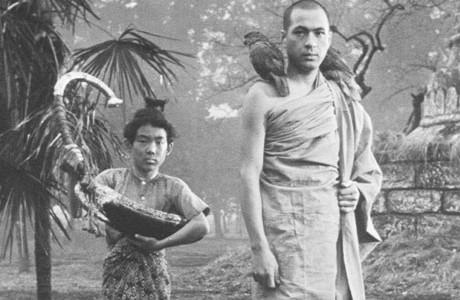
Kon Ichikawa’s deeply humane, spiritually resonant masterpiece is routinely but reductionistically described as “pacifist” or “anti-war.” War, though, is the occasion for the central theme, not the theme itself, which is nothing less than the intractable mystery of suffering and evil, affirmation of spiritual values, and the challenge to live humanely in evil circumstances.
Adapted from the novel of the same name by Michio Takeyama, The Burmese Harp‘s simple, almost fable-like narrative follows a division of exhausted Japanese soldiers stationed in Burma, who struggle to keep their spirits and humanity alive by singing. The universality of the soldiers’ melancholy circumstances and simple longing is emphasized by the one tune to which they return again and again, Hanyu no Yadu or “There’s No Place Like Home.”
Although the story dwells on war-related horrors, The Burmese Harp‘s message is not simply that war causes suffering. Nor, despite its Buddhist milieu, does the film endorse the Buddhist doctrine that suffering (dukkha) is caused by desire (tanha). Instead, the film declares, like the Book of Job, that we mortals do not know why suffering happens. Rather than diagnosing a cause, The Burmese Harp emphasizes the importance of compassion, humility, and spirituality in facing up to the disease.
—Steven Greydanus
- Directed by: Kon Ichikawa
- Produced by: Masayuki Takagi
- Written by: Natto Wada Michio Takeyama
- Music by: Akira Ifukube
- Cinematography by: Minoru Yokoyama
- Editing by: Masanori Tsujii
- Release Date: 1956
- Running Time: 116
- Language: Burmese, Japanese, English
Arts & Faith Lists:
2010 Top 100 — #20
2011 Top 100 — #50
2012 Top 25 Road Films — #11
2020 Top 100 — #56